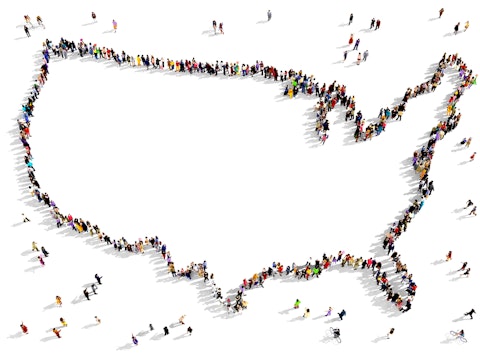In this article, we will take a look at the 20 countries with the lowest population growth in the world. If you would like to skip our discussion on the population trends across the country, you can go to the 5 Countries with the Lowest Population Growth in the World.
In 1950, the global population stood at just 2.5 billion. By 2023, that number has more than tripled, reaching a staggering 8 billion. The UN predicts a steady climb in global population, with estimates reaching 8.5 billion by 2023, 9.7 billion by 2050, and a projected peak of 10.4 billion by 2100. This also indicates a slowing world population growth rate.
One of the main reasons behind this slow pace of growth is the declining fertility rate. Fertility rates have decreased in recent decades across a significant portion of the world. Currently, more than half of the global population resides in countries where a woman has, on average, less than 2.1 children in their lifetime. Since the late 1970s, developed nations across Europe and North America have witnessed a persistent decline in birth rates. Several countries have even seen their fertility rates dip below 1.4 births per woman. Consequently, migration has emerged as the primary driver of population growth in these regions, a trend expected to persist in the future.
Regions like Sub-Saharan Africa and Central and Southeast Asia have experienced very high population growth rates in 2021. Many of the top 10 fast-growing population countries are located across these areas. These countries have some of the highest population growth rates in the world, mainly due to the above-average fertility rates.
The global population is expected to continue growing due to a decrease in mortality rates and an increase in life expectancy. Average life expectancy is expected to reach 77.3 by 2050. This upward trend in longevity is reshaping the population structure, with an increase in the number of individuals aged 65 and above. In fact, the growth rate of this age group is outpacing that of the younger demographics. By 2050, projections suggest the global population over 65 will be more than double the number of children under 5 and will approximately equal the number of children under 12.
Growth of the Global Retirement Home Service Market
Keeping these demographic changes in view, the global retirement home service market is expected to be valued at $14.2 billion by 2032, according to Allied Market Research. The market is predicted to expand at a compound annual growth rate of 4.2% from 2023 to 2032. North America holds the lion’s share in this market, and it is expected that the market in North America will continue to grow at a rate of 3.8% per annum till 2032, reaching $5,417.8 million. Key industry players include Brookdale Senior Living Inc. (NYSE:BKD), Genesis Healthcare Inc. (OTC:GENN), and ABM Industries Incorporated (NYSE:ABM).
Brookdale Senior Living Inc. (NYSE:BKD) is a well-known company for retirement homes and senior living facilities. The company’s recently announced full-year results for 2023 showed substantial growth driven by high occupancy rates.
Genesis Healthcare Inc. (NYSE:GENN) is another well-known name in the senior living facilities market. Recently, 19 of the company’s facilities located in 9 states were listed among the Best Nursing Homes 2024 in the US News and World Report.
ABM Industries Incorporated (NYSE:ABM), primarily a facility management service company, also has a significant influence in the senior living facilities market. With more than four decades of experience in this area, the company provides multiple services to senior living properties.

Arthimedes/Shutterstock.com
Our Methodology
To shortlist the 20 countries with the lowest population growth in the world, we consulted the latest data from the CIA World Factbook. The population growth rate measures the average annual percentage change in population size across countries as of 2023. We have ranked the countries in descending order based on their average annual population growth rates. Our list excludes island nations or territories.
By the way, Insider Monkey is an investing website that tracks the movements of corporate insiders and hedge funds. By using a consensus approach, we identify the best stock picks of more than 900 hedge funds investing in US stocks. The top 10 consensus stock picks of hedge funds outperformed the S&P 500 Index by more than 140 percentage points over the last 10 years (see the details here). Whether you are a beginner investor or a professional one looking for the best stocks to buy, you can benefit from the wisdom of hedge funds and corporate insiders.
20 Countries with the Lowest Population Growth in the World
20. Colombia
Population Growth Rate: 0.54%
Colombia’s population is aging rapidly. The birth rate has been steadily declining, with a significant drop of 7.7% in 2022 compared to the previous year. In the second half of 2023, it decreased by 10.5%. This trend is expected to continue, leading to a future with a much larger proportion of elderly citizens. Projections suggest that by 2060, two out of three people in Colombia will be retired.
19. Sweden
Population Growth Rate: 0.51%
Sweden’s population growth in 2023 hit a 22-year low, according to Statistics Sweden. The population increased by just 30,200 people, reaching 10.5 million. This is a significant slowdown compared to previous years. Several factors contributed to this slow growth. These include fewer births, lower immigration, and increased emigration.
18. Peru
Population Growth Rate: 0.5%
Peru’s population witnessed moderate growth in 2023. According to the National Institute of Statistics and Informatics (INEI), the population reached an estimated 33.73 million. This growth is primarily driven by a birth rate exceeding the death rate since net migration was negative.
17. United Kingdom
Population Growth Rate: 0.49%
The United Kingdom’s population has been steadily growing. This growth is primarily driven by a combination of factors. Firstly, while the birth rate remains above zero, it has been declining in recent years. However, it is still more than the death rate, which means a positive natural population growth. Moreover, net immigration is also driving growth. The UK attracts skilled workers and international students, leading to a steady influx of new residents.
16 Netherlands
Population Growth Rate: 0.48%
The Netherlands saw a significant slowdown in population growth in 2023. Compared to 2022’s net increase of 221,000 residents, the growth rate dropped by over 36%. The number of deaths in the Netherlands outpaced the number of births in 2023. This resulted in negative natural population growth. Additionally, immigration dipped in 2023. This decrease was coupled with a rise in emigration, particularly among non-Dutch residents.
15. Denmark
Population Growth Rate: 0.44%
Denmark’s population growth slowed down in 2023. The national population grew by a modest 0.4%, which is significantly lower than the 1.0% growth observed in 2022. There was a negative natural population change in 2023. This means the number of deaths outpaced the number of births. Moreover, the immigration rate also declined in 2023 by 19% compared to 2022. Denmark is among the top 15 countries with the lowest population growth in the world.
14. Azerbaijan
Population Growth Rate: 0.43%
Azerbaijan’s population has been increasing, although at a very slow pace, reaching an estimated 10.45 million in April 2024. This growth is primarily driven by a birth rate exceeding the death rate, as the net migration rate is negative. The country has a relatively young population, but fertility rates are low at 1.93 children per woman.
13. North Korea
Population Growth Rate: 0.4%
Recent estimates indicate a population growth rate of approximately 0.4% in North Korea as of 2023. The average birth rate stands at 1.79 births per woman during their lifetime in the country. Factors such as economic challenges, delayed marriage, and government policies may contribute to this decline in birth rates.
12. Austria
Population Growth Rate: 0.31%
Austria’s average annual population growth rate sits at 0.31% as of 2023. The birth rate stands at 9.39 births per 1,000 people, while a slightly higher death rate of 9.86 per 1,000 people indicates a small natural decline in population. This suggests that, on average, more individuals are passing away than being born within Austria. However, immigration plays a role in counterbalancing the natural population decline and contributes to overall growth.
11. Guyana
Population Growth Rate: 0.28%
As of 2023, Guyana’s population growth rate remains relatively low, standing at around 0.28%. Despite a birth rate of 16.7 per 1000 people, which exceeds the death rate of 7 per 1000 individuals, the country faces a challenge with emigration. Approximately 55% of Guyana’s population resides abroad, making it one of the countries with the highest emigration rates globally. This significant outflow of citizens, particularly young adults seeking opportunities elsewhere, has an impact on population growth within the country.
10. Uruguay
Population Growth Rate: 0.27%
Uruguay is among the top 10 countries with the lowest population growth in the world. Domestic births are declining across the country, and the population is aging. However, this slowdown is being counterbalanced by a significant rise in immigration. The arrival of nearly 62,000 immigrants in recent years has played a key role in maintaining Uruguay’s population growth.
9. South Korea
Population Growth Rate: 0.23%
South Korea faces a complex demographic challenge in the form of a stagnant population growth rate. As of 2023, the country’s annual population growth rate is around 0.23%, which is a significant drop compared to previous decades. A key factor behind the slowing population growth is the low birth rate. South Korea’s birth rate has fallen dramatically to just 0.72 babies per woman over their lifetime as of 2023. This decline is attributed to various factors, including economic and societal pressures.
8. Finland
Population Growth Rate: 0.22%
Finland’s sluggish population growth primarily stems from low birth rates. In 2023, the country witnessed 17,786 fewer births than deaths. The birth rate in Finland has steadily declined for over a decade, plummeting by a third since 2010. Hence, population growth has relied on net immigration for several years.
7. France
Population Growth Rate: 0.21%
France is experiencing a significant demographic shift. According to the latest national statistics, the birth rate has dipped to its lowest point since World War II, with a decline of 6.6% in 2023. This decline coincides with a record high in life expectancy, which is currently 80 years for men and 85.7 for women. These contrasting trends are leading to a rapid aging of the French population. France is among the top 10 countries with the lowest population growth in the world.
6. Thailand
Population Growth Rate: 0.2%
As of 2023, Thailand’s annual population growth rate sits at 0.2%, marking a significant decrease from past decades. This slowdown can be attributed mainly to the low birth rate. Thailand has witnessed a steady decline in birth rates over the last several decades. As per the most recent records, the birth rate was estimated at 9 births per 1000 people. Thailand has implemented measures such as offering childcare services and access to fertility centers to address this issue.
Click to continue reading and see the 5 Countries with the Lowest Population Growth in the World.
Suggested Articles:
- 15 Fastest Growing Metro Areas in the US
- 15 Biggest Defense Companies in Asia
- 20 Largest Video Game Publishers by Revenue in the World
Disclosure: None. 20 Countries with the Lowest Population Growth in the World is originally published on Insider Monkey.





